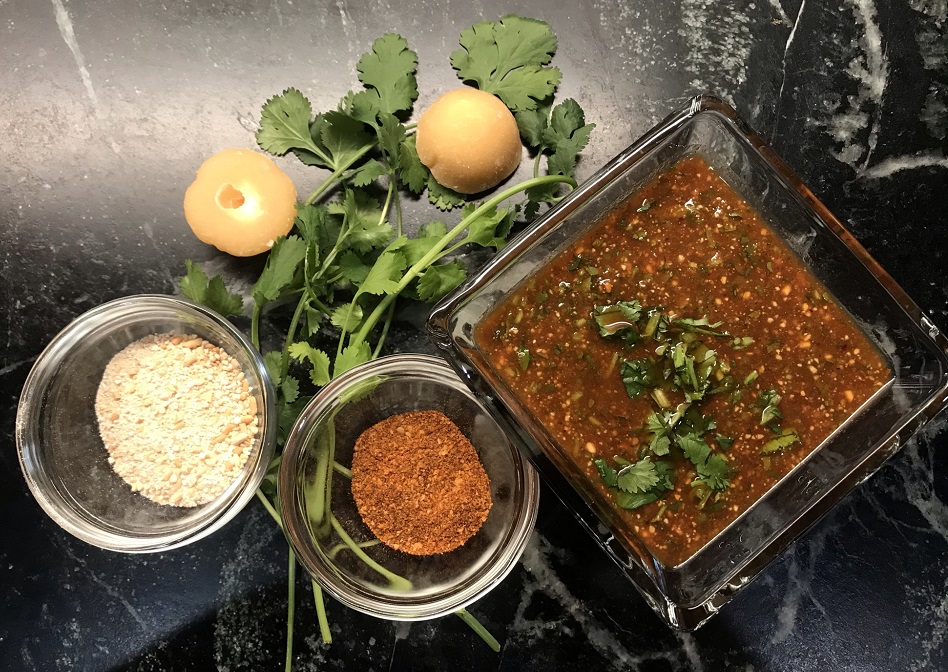Nam Jim Jaew (น้ำจิ้มแจ่ว) is a popular Thai chili dipping sauce that accompanies grilled meats. (“Nam Jim” means dipping sauce and “Jaew” is the actual name). This sauce is not for the meek – it is a balancing act between sour, salty, sweet, and spicy, which results in something big and bold. The sauce is thickened by the toasted rice powder, which also gives it a mild nutty flavor and a slightly crunchy texture.
While there may be differences in this recipe from family to family or restaurant to restaurant, the prevailing ingredients are always the same: Tamarind, fish sauce, sugar (usually palm sugar), Thai dry chili powder, toasted rice powder, and cilantro. The quantities of each ingredient is often adjusted to suit individual tastes. Some recipes may add shallots and squeeze of lime.
If you are storing leftovers of the sauce in the fridge, you may need to add a few spoons of water next time you use it. The toasted rice will likely have absorbed some of the liquid, leaving you with a drier sauce. Adding a little bit of water will solve this issue.
Once you have all the ingredients on hand, this sauce comes together in minutes. So next time you grill steak, pork or chicken, ditch the mash potatoes and gravy and replace it with Jaew sauce on the side for dipping and serve it with rice and stir-fry vegetables. BAM! instant Thai food.
About the Ingredients
Tamarind Concentrate
Tamarind is a fruit widely grown in warm, wet regions of the world (Asia, Central/South America). The pulp of the tamarind is usually diluted in water to create a paste or liquid (of varying consistency) then added to drinks, soups, curries, and other dishes. It is a widely used ingredient in many Asian, Indian, and Latin dishes to add a sour tanginess without the citrus notes.
You can buy tamarind in three main forms: pulp, paste, or concentrate. Pulp (may have seeds or be seedless) form comes in square blocks, while pastes and concentrates often come in a jar. If you buy pulp, you will need to do a little prep work first. To prepare pulp, break of a chunk from the block and soak in hot water for about 30 minutes. The pulp will start to break up and loosen; at this stage remove any seeds. Then take your hand and squeeze and squish the pulp in the water until you have a liquidy concentrate. The thickness of the concentrate will depend on how much water you’ve used.
To save from all this work, you can look for tamarind concentrate! Mexican, Indian, and many other Asian cuisines use tamarind so this should not be too difficult to find. Of course, if all else fails, you can find it online. I am most familiar with brands from Thailand so that’s what I would recommend for my recipes (even if that means I have to process the pulp myself sometimes *sigh*).
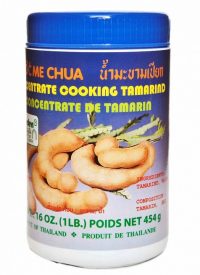
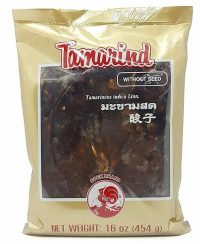
Toasted Rice Powder
Toasted rice powder starts with Thai Sticky Rice, often labeled as “Sweet Rice” or “Thai Sweet Rice”. It’s not sweet by any stretch of the imagination so the name is a bit of a misnomer. Look for the types that are from Thailand or labeled as Thai. If nothing else, ensure it is of the long grain variety. You can find Thai sticky rice in most Asian grocery stores or online.
To make toasted rice powder, take a cup or two of the uncooked rice grains and toast them in a dry (no oil) hot pan (the same way you would toast spices to release their aromatics). Keep the pan dry and hot, and keep the rice kernels moving (i.e. stirring frequently). The kernels will start to toast (turn brown); take care not to let the kernels burn or over toast. Once most of the rice turns a light brown color, remove it from the heat and let it cool. Then blend in a spice grinder or grind in a mortar & pestle until you are left with a powder. Store in a jar or other airtight container for future uses.

Grounded Thai Chili
Grounded Thai dry chili is an essential Thai condiment, in the same way that pepper is a common condiment in Western cuisines. Thai people who love spice (like me) add it to almost everything. You typically cannot buy this so you will have to make it yourself. Start with some dried Thai chilies, which you can buy online or at Asian grocery stores. Toast the chilies in a dry pan (like the toasted rice above), remove the stems, then grind in a spice grinder. If you cannot find Thai chilies, you can substitute with any other dry hot chilies used in Mexican cooking (chile de arbol, chile japones, etc.)
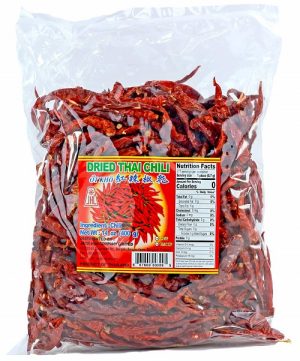
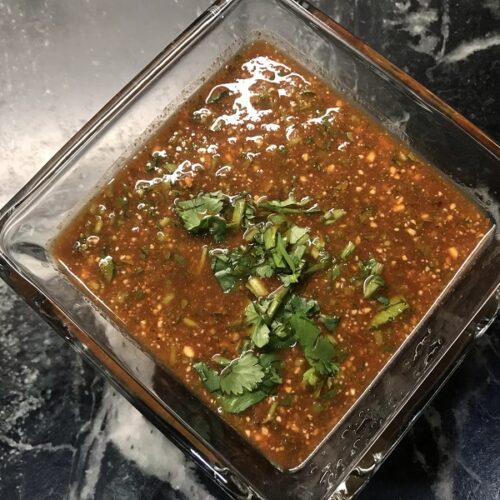
Jaew Dipping Sauce (น้ำจิ้มแจ่ว)
Ingredients
- 1/4 cup tamarind concentrate
- 1/4 cup water
- 1½ tbsp fish sauce
- 2 tbsp palm sugar
- 1 tbsp dried thai chilies, grinded in a powder (see notes)
- 1 tbsp toasted rice, (see notes)
- 1 handful cilantro leaves & stems, chopped
- 1 small shallots, sliced (optional)
How I Make It
- Combine all ingredients. Taste and adjust according your preference. The sauce should be a good balance of spicy, salty, and sour. (see notes)
Notes
- Grounded toasted rice is sticky rice that has been dry roasted in a pan until it just starts to brown, and then grounded up (either in a spice grinder or mortar & pestle)
- Thai dry chilies can be bought in online or in Asian grocery stores. You can toast it in a dry pan, which releases some of its oils and aroma. I often skip the toasting out of sheer laziness. After toasting, (or not), grind it into a powder in a spice grinder and store in an airtight container for future uses.
- This recipe assumes you are using tamarind concentrate. If you started with a different form of tamarind, you may need to adjust the sour note by adding more tamarind (or squeeze of lime) if not tangy enough, or add a little more water if too tangy.

